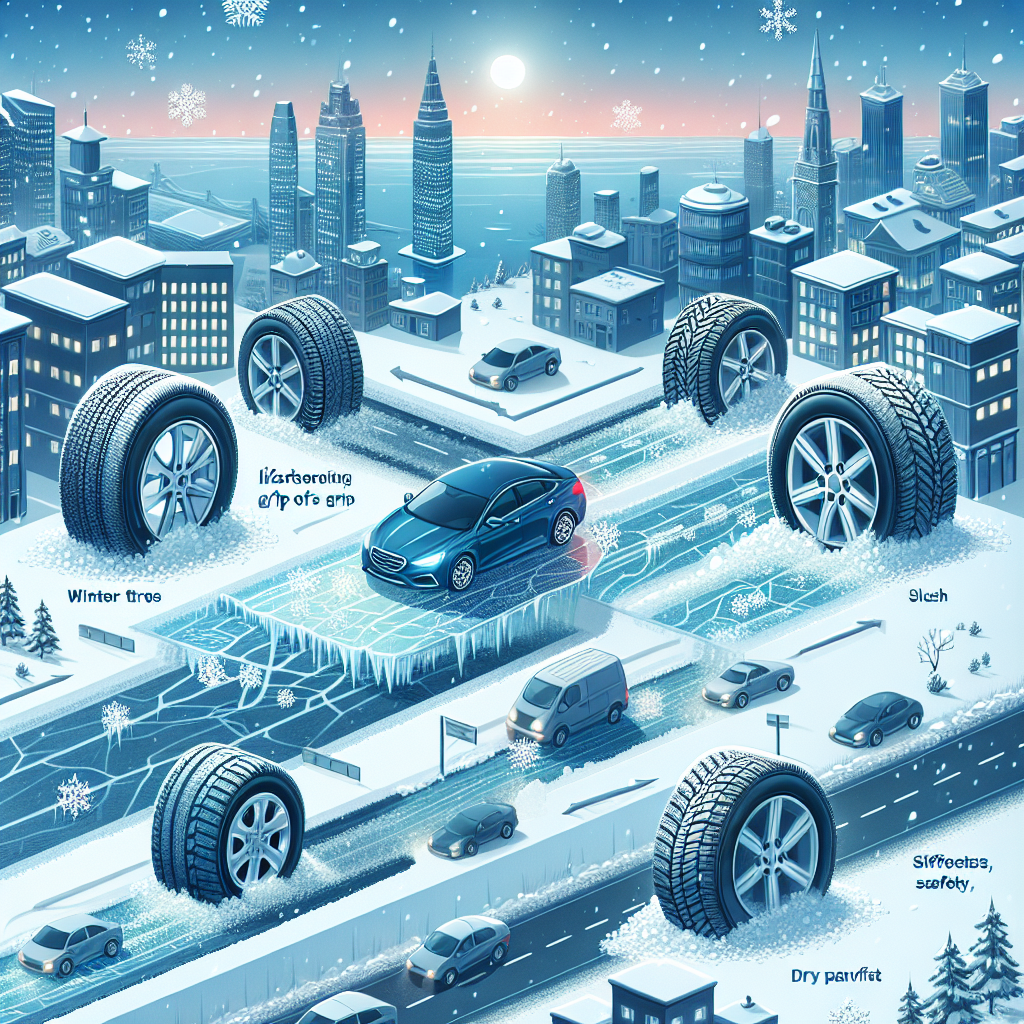Imagine navigating through the busy streets of the city during winter, encountering everything from fresh snow to sleet and icy surfaces. As you maneuver through these varying road conditions, one question lingers in your mind: How do winter tires perform in urban environments? In this article, we will explore the performance of winter tires in city settings with diverse road conditions, shedding light on whether these specialized tires can truly make a difference in enhancing your safety and confidence during the colder months. Join us as we uncover the insights behind the performance of winter tires on urban roads, and discover how they can be the perfect ally in conquering the challenges of winter driving.

Benefits of Winter Tires
Enhanced Traction
One of the main benefits of winter tires is their enhanced traction on snowy and icy roads. Winter tires are specifically designed with deep tread patterns and unique rubber compounds that provide better grip on slippery surfaces. This improved traction helps to ensure that your vehicle can start, stop, and navigate turns more effectively, reducing the risk of accidents and improving overall road safety.
Improved Handling
In addition to enhanced traction, winter tires also offer improved handling in urban environments. The special tread patterns and rubber compounds of these tires allow for better control and responsiveness, even on wet or slushy surfaces. With winter tires, you’ll experience less skidding and sliding, giving you the confidence to navigate through urban streets with ease.
Better Braking
Winter tires are designed to improve braking performance in cold weather conditions. The unique rubber compounds used in these tires stay flexible in low temperatures, allowing for better contact with the road and shorter stopping distances. This can be especially valuable in urban environments where sudden stops may be necessary due to traffic congestion or pedestrian crossings.
Increased Stability
Winter tires also contribute to increased stability while driving in urban environments. The specially designed tread patterns help to channel water and slush away from the tire’s contact patch, reducing the risk of hydroplaning and improving overall stability. This can be particularly advantageous on poorly maintained or uneven urban roads, where stability is crucial to maintaining control of your vehicle.
Factors Affecting Winter Tire Performance
Temperature
The temperature plays a crucial role in the performance of winter tires. These tires are optimized to perform at temperatures below 45°F (7°C). As the temperature drops, the rubber compounds in winter tires remain pliable, providing the necessary grip and traction. In warmer temperatures, however, the rubber becomes too soft, which can negatively affect the tire’s handling and wear.
Road Conditions
The condition of the roads in urban environments can greatly impact the performance of winter tires. While winter tires excel on snow and ice, they may not perform as well on dry or wet pavement. The deep tread patterns and soft rubber compounds that make winter tires effective on winter surfaces can cause increased noise, reduced fuel efficiency, and accelerated wear on dry roads.
Tread Depth
The tread depth of winter tires significantly affects their performance. Winter tires come with deeper treads compared to all-season tires, allowing for better grip and traction on snow and ice. It is essential to regularly check the tread depth of your winter tires to ensure optimal performance. As the tread depth wears down, the effectiveness of the tires on slippery surfaces diminishes.
Tire Type
The type of winter tire you choose can also impact its performance in urban environments. There are two main types of winter tires: studless and studded. Studless winter tires use complex tread patterns and rubber compounds to provide traction on ice and snow, while studded tires feature metal studs embedded in the tread for even greater grip on icy surfaces. The choice between these two types depends on the specific road conditions you encounter in your urban area.
Driving Habits
Your driving habits can also influence the performance of winter tires in urban environments. Even with the best winter tires, it is essential to adjust your driving techniques to match the conditions. Avoid sudden and aggressive movements, maintain a safe distance from other vehicles, and be prepared for changing weather conditions. Responsible driving practices combined with winter tires will optimize your safety on urban roads.
Winter Tire Technology
Snow Tread Patterns
One of the key features of winter tires is their unique snow tread patterns. These patterns are designed to bite into snow and ice, providing the necessary traction for safe driving. Snow tread patterns often feature deep grooves, sipes, and multiple edges that enhance grip and reduce the risk of sliding. The variations in tread design allow for superior performance in different winter road conditions.
Tire Composition
The composition of winter tires is carefully designed to ensure optimal performance on cold and slippery surfaces. Winter tires use a specific rubber compound that remains flexible in low temperatures, allowing the tire to conform to the road and maintain grip. Additionally, winter tires often feature silica or other additives that enhance traction and improve overall handling in winter conditions.
Siping
Siping is a technique used in the manufacturing of winter tires to improve traction and braking performance. It involves creating small slits or cuts in the tread blocks of the tires. These sipes help to improve grip by increasing the tire’s biting edges. When the tire makes contact with the road, the sipes open up, creating additional traction. This technology is particularly effective on icy and wet surfaces.
Studding
Some winter tires are designed with the option to be studded. Studded tires have metal studs embedded in the tread, which provide additional traction on icy roads. These studs grip the ice surface, allowing for improved acceleration, braking, and cornering. However, it’s important to note that studded tires are not legal in all areas and may cause additional wear on road surfaces.
Performance in Wet Conditions
While winter tires are known for their performance on snow and ice, they also offer advantages in wet conditions. The deep tread patterns and specialized rubber compounds of winter tires help to channel water away from the tire’s contact patch, reducing the risk of hydroplaning. This improved water dispersion enhances stability, grip, and braking performance on wet urban roads.
Winter Tires vs. All-Season Tires
Traction on Snow and Ice
One of the most significant differences between winter tires and all-season tires is their traction on snow and ice. Winter tires are specifically designed for cold weather conditions and provide superior grip on slippery surfaces. The deeper tread patterns and unique rubber compounds of winter tires allow for better traction and control, ensuring safety in urban environments with snowy or icy roads. All-season tires, on the other hand, are more versatile but do not provide the same level of performance on winter surfaces.
Performance in Cold Weather
Winter tires outperform all-season tires in cold weather due to their specialized rubber compounds. While all-season tires may become stiff and lose traction in low temperatures, winter tires remain flexible and maintain grip, ensuring better handling and braking. In urban environments with freezing temperatures, having winter tires can make a significant difference in overall driving performance and safety.
Handling and Braking
Winter tires offer improved handling and braking compared to all-season tires on snow, ice, and other slippery surfaces. The deep tread patterns, siping, and soft rubber compounds of winter tires provide better responsiveness and control, reducing the chances of skidding or sliding. All-season tires may struggle to deliver the same level of stability and performance in urban environments with challenging road conditions.
Wear and Tear
It’s important to consider the wear and tear on tires in urban environments when comparing winter tires and all-season tires. Winter tires are specifically designed for cold weather conditions and excel in performance during the winter months. However, if used year-round in urban settings with mostly dry or warm conditions, winter tires may wear out more quickly. All-season tires, on the other hand, are designed to provide satisfactory performance throughout the year, making them a more durable option.
Cost Considerations
When considering winter tires versus all-season tires, cost is an important factor to consider. Winter tires are an additional expense as they need to be purchased and potentially stored when not in use. However, investing in winter tires can be seen as a long-term investment in safety and peace of mind during the winter months. All-season tires, while generally less expensive, might not provide the same level of performance and safety in challenging urban winter conditions.
Environmental Impact
The environmental impact of winter tires versus all-season tires should also be considered. Winter tires, with their specialized rubber compounds and heavier tread patterns, may have a slightly higher impact on fuel efficiency compared to all-season tires. However, the benefits of improved safety and performance in winter conditions should be balanced with the potential environmental effects. Responsible tire maintenance, including proper inflation and rotation, can help mitigate any negative impact.

Winter Tires and Urban Environments
City Road Conditions
Winter tires are well-suited for urban environments with challenging road conditions. In cities, roads may be less maintained compared to highways, increasing the likelihood of snow, ice, and slush accumulation. Winter tires’ enhanced traction and control allow for safer maneuvering on these slippery urban roads, reducing the risk of accidents and ensuring a smoother driving experience.
Packed Snow and Ice
Urban areas often experience packed snow and ice on the roads due to traffic and constant use. Winter tires excel in these conditions as their specialized tread patterns and rubber compounds can effectively grip the packed snow and ice, reducing skidding and sliding. With winter tires, you’ll have increased confidence and stability when driving through these common urban winter road conditions.
Slush and Wet Surfaces
Slush and wet surfaces are common in urban environments, especially after snowfall or during periods of melting. Winter tires’ advanced tread patterns and water-channeling capabilities make them more effective in these conditions compared to all-season tires. The ability of winter tires to quickly disperse water and slush allows for improved traction and reduced chances of hydroplaning on urban roads.
Bumpy or Uneven Roads
Urban roads can be bumpy and uneven due to heavy traffic and poor maintenance. Winter tires’ enhanced stability and improved handling help to minimize the impact of these road conditions. The specialized tread patterns and rubber compounds of winter tires ensure optimal grip and control, providing a smoother and safer driving experience even on rough urban roads.
Maneuverability and Cornering
Maneuverability and cornering are vital aspects of driving in urban environments. Winter tires, with their improved traction and responsiveness, allow for better maneuverability and cornering. The advanced tread patterns and optimized rubber compounds provide the grip needed to navigate narrow city streets, and the enhanced stability contributes to safer and more confident turning at intersections and corners.
Stopping Distance
The ability to stop safely and quickly is crucial in urban environments, especially when encountering traffic congestion or pedestrian crossings. Winter tires’ superior braking performance on snow and ice, combined with their enhanced grip on wet surfaces, leads to shorter stopping distances. This reduced stopping distance can make a significant difference in avoiding accidents or collisions in urban settings.
Start-up Traction
Winter tires’ enhanced start-up traction is particularly advantageous in urban environments with traffic congestion or stop-and-go driving. Whether you need to accelerate quickly from a stoplight or merge into traffic, winter tires provide the necessary grip and control for smooth and confident start-ups. This increased traction reduces the risk of wheelspin and improves overall acceleration performance.
Winter Tires and Urban Driving Challenges
Traffic Congestion
Traffic congestion is a common challenge in urban areas, especially during peak commuting hours. Winter tires can help mitigate this challenge by providing improved traction and stability. With winter tires, you’ll have increased confidence when navigating through slow-moving or stop-and-go traffic, as well as an improved ability to accelerate and brake smoothly in these congested conditions.
Lane Transitions
Lane transitions require careful maneuvering, especially in heavy urban traffic. Winter tires’ enhanced handling and grip allow for smoother lane transitions, reducing the risk of sliding or losing control. The advanced tread patterns and optimized rubber compounds of winter tires ensure optimal traction during these lane changes, enhancing overall safety and control in urban driving situations.
Intersection Safety
Intersections in urban environments can be particularly challenging, with multiple lanes, various turning options, and pedestrian crossings. Winter tires’ improved braking performance and enhanced grip on snow and ice provide an added level of safety at intersections. With winter tires, you’ll have increased control when approaching intersections, reducing the risk of skidding or sliding during braking and turning maneuvers.
Narrow Streets
Urban areas often have narrow streets, which require precise vehicle control and maneuverability. Winter tires’ enhanced grip and stability make them ideal for navigating these narrow urban streets. With winter tires, you’ll have the confidence to safely maneuver through tight spaces, reducing the risk of scraping curbs or other objects and ensuring a smoother driving experience.
Poorly Maintained Roads
Poorly maintained roads are a common challenge in urban environments, with potholes, cracks, and uneven surfaces. Winter tires’ improved handling and stability help to minimize the impact of these road conditions. The advanced tread patterns and specialized rubber compounds of winter tires allow for better grip and control, making urban driving over poorly maintained roads safer and more comfortable.
Pedestrian Safety
Pedestrian safety is a top priority in urban areas. Winter tires contribute to pedestrian safety by providing better traction and control in snowy, icy, or wet conditions. The enhanced grip of winter tires reduces the risk of skidding or sliding, ensuring that your vehicle remains under control and reducing the chances of accidental collisions with pedestrians. Winter tires are therefore an important aspect of responsible urban driving.

Urban Benefits of Winter Tires
Safety
The primary benefit of winter tires in urban environments is increased safety. The enhanced traction, improved handling, and better braking performance of winter tires reduce the risk of accidents and ensure a safer driving experience. With their specialized design and technology, winter tires provide peace of mind when navigating challenging road conditions in urban areas.
Confidence in All Conditions
Winter tires instill confidence in urban drivers in all weather conditions. Whether it’s snow, ice, slush, or wet surfaces, winter tires excel in their ability to provide optimal grip and control. Having the assurance that your tires can handle any winter condition allows you to confidently tackle your daily commute in the city, knowing that you’re prepared for whatever urban roads throw your way.
Reduced Accident Risks
With their superior performance on winter surfaces and improved stability, winter tires significantly reduce the risk of accidents in urban environments. The improved handling and braking capabilities of winter tires help you react quickly and confidently when faced with sudden stops, lane changes, or unexpected road conditions. By minimizing the chances of skidding or sliding, winter tires play a vital role in preventing accidents and collisions.
Shorter Commute Times
Winter tires can help reduce commute times in urban environments by improving overall driving performance. The enhanced traction and control of winter tires allow for smoother acceleration, quicker braking, and more confident maneuvering through traffic. With winter tires, you’ll spend less time worrying about road conditions and more time enjoying a quicker and more efficient commute.
Ability to Reach Essential Services
In urban settings, access to essential services is crucial, especially during winter weather conditions. Winter tires ensure that you can safely and reliably reach important destinations like hospitals, grocery stores, and workplaces, regardless of the weather. With their superior performance on snow and ice, winter tires enable you to maintain your daily routines and access essential services when you need them the most.
Minimized Vehicle Damage
Winter tires can also minimize vehicle damage in urban environments. With their enhanced grip and stability, winter tires reduce the risk of sliding into curbs, potholes, or other objects that could damage your vehicle. The advanced tread patterns and optimized rubber compounds of winter tires provide added protection against road hazards, preserving the condition of your vehicle and potentially saving you from costly repairs.
Peace of Mind
Above all, winter tires provide peace of mind during winter driving in urban areas. Knowing that you have the necessary traction, control, and responsiveness to safely navigate through challenging road conditions brings a sense of confidence and peace. With winter tires, you can focus on enjoying the journey and arriving at your destination safely, regardless of the winter weather outside.
Urban Drawbacks of Winter Tires
Cost
One of the primary drawbacks of winter tires in urban areas is the cost associated with purchasing and maintaining them. Winter tires are an additional expense that may require a separate set of rims and storage, increasing the overall cost. However, it’s important to consider the long-term investment in safety and peace of mind that winter tires provide, which can outweigh the upfront cost.
Storage Space
Storing winter tires can be a challenge in urban environments with limited space. Depending on the size of your vehicle, finding adequate space to store a full set of winter tires during the offseason may be difficult. It’s important to consider your available storage options before investing in winter tires and ensure that you have a suitable place to store them when not in use.
Limited Usefulness in Mild Winters
In urban areas with mild winters or infrequent snowfall, the usefulness of winter tires may be limited. If you live in a region where snow and ice are rare occurrences, the investment in winter tires may not provide significant benefits. All-season tires may be a more practical option in these situations, as they provide satisfactory performance in a variety of weather conditions.
Inconvenience of Tire Swapping
Switching between winter tires and all-season tires can be inconvenient in urban environments. The process of tire swapping requires time, effort, and potentially additional expenses if you take your vehicle to a mechanic. Finding a suitable time and place for the swap can be challenging, especially if you have a busy schedule. However, the improved safety and performance of winter tires make the inconvenience worth it for many urban drivers.

Tips for using Winter Tires in Urban Environments
Monitor Tire Pressure Regularly
Ensure that your winter tires are properly inflated by regularly monitoring tire pressure. Cold temperatures can cause tire pressure to drop, affecting their performance. Check the recommended tire pressure for your vehicle and adjust as necessary to maintain optimal performance in urban winter conditions.
Check Tread Depth
Regularly check the tread depth of your winter tires to ensure they still provide sufficient grip. The minimum legal tread depth is typically 2/32 of an inch, but for optimal traction in winter conditions, a tread depth of at least 6/32 is recommended. If your winter tires are worn beyond this level, it may be time to consider replacing them for optimal safety and performance.
Avoid Sudden Movements
In urban driving, where there are often unexpected stops, turns, and lane changes, it’s important to avoid sudden movements. Abrupt acceleration, braking, and steering can increase the risk of skidding or sliding, even with winter tires. Practice smooth and gradual movements to maximize the effectiveness of your winter tires in urban environments.
Maintain a Safe Distance
Maintaining a safe distance from the vehicle in front is crucial in urban driving, especially on icy or slippery roads. The increased stopping distance required in winter conditions means you should allow for a greater gap between your vehicle and the one ahead. This gives you more time to react and reduces the risk of collisions due to sudden braking or loss of control.
Adapt Driving Techniques to Road Conditions
Adapting your driving techniques to match the road conditions is essential in urban environments. Pay attention to changes in road conditions, such as icy patches or slush, and adjust your speed and braking accordingly. Smooth and controlled movements, along with maintaining a safe speed, help maximize the performance of your winter tires on urban roads.
Be Prepared for Changing Weather
Weather conditions can change rapidly in urban areas, especially during winter months. Stay informed about weather forecasts and be prepared for sudden changes. If conditions become too severe, consider postponing or rescheduling your travel plans to prioritize safety. Winter tires can provide an added level of confidence, but being prepared for changing weather is equally important.
Consider Adding Weight to your Vehicle
Adding weight to your vehicle can improve traction and stability on icy or snowy roads. Use sandbags or other heavy items to provide additional weight over the rear axle, which can increase traction and prevent the rear of the vehicle from sliding. However, be cautious not to exceed your vehicle’s maximum weight capacity.
Keep an Emergency Kit
Carrying an emergency kit in your vehicle is essential in all driving conditions, especially during winter. Include items such as a snow shovel, ice scraper, blanket, flashlight, first aid kit, and extra warm clothing. In the event of an emergency or breakdown, having these items readily available can make a significant difference in your safety and well-being.
Conclusion
Winter tires offer numerous benefits for urban drivers facing varying road conditions. Their enhanced traction, improved handling, and better braking performance ensure safer and more confident driving in snowy, icy, and wet urban environments. Despite the drawbacks of cost and storage, winter tires provide peace of mind, shorter commute times, and increased access to essential services. By following tips for using winter tires in urban environments and adapting driving techniques to match road conditions, you can make the most of their superior winter performance and enjoy a safer driving experience during the colder months.


